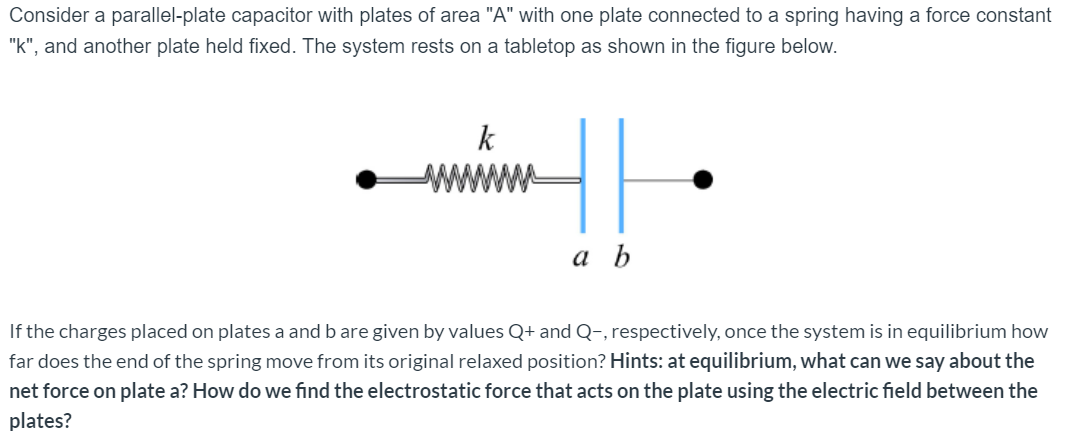Consider a parallel-plate capacitor with plates of area "A" with one plate connected to a spring having a force constant "k", and another plate held fixed. The system rests on a tabletop as shown in the figure below. k а Ь If the charges placed on plates a and b are given by values Q+ and Q-, respectively, once the system is in equilibrium how far does the end of the spring move from its original relaxed position? Hints: at equilibrium, what can we say about the net force on plate a? How do we find the electrostatic force that acts on the plate using the electric field between the plates?
Consider a parallel-plate capacitor with plates of area "A" with one plate connected to a spring having a force constant "k", and another plate held fixed. The system rests on a tabletop as shown in the figure below. k а Ь If the charges placed on plates a and b are given by values Q+ and Q-, respectively, once the system is in equilibrium how far does the end of the spring move from its original relaxed position? Hints: at equilibrium, what can we say about the net force on plate a? How do we find the electrostatic force that acts on the plate using the electric field between the plates?
Principles of Physics: A Calculus-Based Text
5th Edition
ISBN:9781133104261
Author:Raymond A. Serway, John W. Jewett
Publisher:Raymond A. Serway, John W. Jewett
Chapter19: Electric Forces And Electric Fields
Section: Chapter Questions
Problem 11CQ
Related questions
Question
100%
How would I solve this? I attached the screenshot.

Transcribed Image Text:Consider a parallel-plate capacitor with plates of area "A" with one plate connected to a spring having a force constant
"k", and another plate held fixed. The system rests on a tabletop as shown in the figure below.
k
а Ь
If the charges placed on plates a and b are given by values Q+ and Q-, respectively, once the system is in equilibrium how
far does the end of the spring move from its original relaxed position? Hints: at equilibrium, what can we say about the
net force on plate a? How do we find the electrostatic force that acts on the plate using the electric field between the
plates?
Expert Solution
This question has been solved!
Explore an expertly crafted, step-by-step solution for a thorough understanding of key concepts.
This is a popular solution!
Trending now
This is a popular solution!
Step by step
Solved in 2 steps with 2 images

Knowledge Booster
Learn more about
Need a deep-dive on the concept behind this application? Look no further. Learn more about this topic, physics and related others by exploring similar questions and additional content below.Recommended textbooks for you

Principles of Physics: A Calculus-Based Text
Physics
ISBN:
9781133104261
Author:
Raymond A. Serway, John W. Jewett
Publisher:
Cengage Learning

Physics for Scientists and Engineers: Foundations…
Physics
ISBN:
9781133939146
Author:
Katz, Debora M.
Publisher:
Cengage Learning

College Physics
Physics
ISBN:
9781285737027
Author:
Raymond A. Serway, Chris Vuille
Publisher:
Cengage Learning

Principles of Physics: A Calculus-Based Text
Physics
ISBN:
9781133104261
Author:
Raymond A. Serway, John W. Jewett
Publisher:
Cengage Learning

Physics for Scientists and Engineers: Foundations…
Physics
ISBN:
9781133939146
Author:
Katz, Debora M.
Publisher:
Cengage Learning

College Physics
Physics
ISBN:
9781285737027
Author:
Raymond A. Serway, Chris Vuille
Publisher:
Cengage Learning


College Physics
Physics
ISBN:
9781305952300
Author:
Raymond A. Serway, Chris Vuille
Publisher:
Cengage Learning

College Physics
Physics
ISBN:
9781938168000
Author:
Paul Peter Urone, Roger Hinrichs
Publisher:
OpenStax College